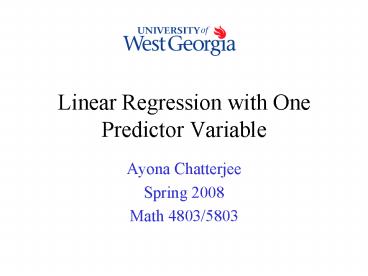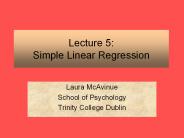Linear Regression with One Predictor Variable - PowerPoint PPT Presentation
1 / 21
Title:
Linear Regression with One Predictor Variable
Description:
The means of these distributions vary in some systematic fashion with X. Note ... (Y) for a sample of children aged 5-10 will show a positive regression relation. ... – PowerPoint PPT presentation
Number of Views:67
Avg rating:3.0/5.0
Title: Linear Regression with One Predictor Variable
1
Linear Regression with One Predictor Variable
- Ayona Chatterjee
- Spring 2008
- Math 4803/5803
2
Introduction
- Statistical methodology that utilizes the
relationship between two quantitative variables. - Use explanatory variables (independent, X) to
predict the outcome/response (dependent, Y). - Introduced by Sir Francis Galton while studying
heights of offspring and parents.
3
Examples
- Sales of a product can be predicted by utilizing
the relationship between sales and amount of
advertising expenditures. - Performance of a student in a test can be
predicted using the students IQ and time spent
studying. - Length of a hospital stay of a surgical patient
can be predicted by using the relationship
between the time in the hospital and the severity
of the operation.
4
Types of Relations between Variables
- Functional Relationship
- A functional relationship between two variables
is expressed by a mathematical formula. If X
denotes the independent variable and Y denotes
the dependent variable, a functional relation is
of the form Y f(X). - Statistical Relationship
- Unlike a functional relation, does not lie on a
straight lie. There is scope for some error.
5
Example of Statistical Relation
- Performance of 10 students were obtained at
mid-semester and at end of semester for a
statistics exam. The data are plotted in the next
slide. The end of semester grades are taken as
dependent (Y) and the mid term grades are assumed
to be the explanatory variable (X).
6
(No Transcript)
7
Basic Concept
- A tendency of the response variable Y to vary
with the predictor variable X in a systematic
fashion. - There is a probability distribution of Y for each
level of X. - A scattering of points around the curve of
statistical relationship. - The means of these distributions vary in some
systematic fashion with X.
8
Note
- A regression model can be linear or curvilinear.
- A regression model can have more than one
predictor variable. - We will look at multiple regression later on.
9
Construction of Regression Models
- Selection of Predictor Variables.
- Construct models with limited number of
explanatory variables to have a practical model. - Choose variables that help in reducing variation
in Y. - Functional Form of Regression Relation.
- Depends on the explanatory variable.
- May be available from existing literature.
- Or else it has to be decided empirically once the
data are collected.
10
Construction of Regression Models
- Scope of Model.
- The regression equation is only valid in the
range of data used to obtain it. - Uses of Regression Analysis
- Description
- Control
- Prediction
11
Regression and Causality
- No cause-and-effect pattern is necessarily
implied by the regression model. - Regression analysis by itself provides no
information about causal patterns and must be
supplemented by additional analyses. - Example Data on size of vocabulary (X) and
writing speed (Y) for a sample of children aged
5-10 will show a positive regression relation.
This does not imply that an increase in
vocabulary causes faster writing speed.
12
Simple Linear Regression Model
- With only one predictor, the model is as follows
- Where
- Yi is the value of the response variable in the
ith trail. - ß0 and ß1 are parameters
- Xi us a known constant, value of the predictor
variable in the ith trail. - ei is the random error term with mean 0, variance
s2 and covariance zero. - i 1n
13
Meaning of Regression Parameters
- The parameters ß0 and ß1 are called regression
coefficients. - Here ß1 is the slope of the regression line and
indicates the change in the mea of the
probability distribution of Y per unit increase
in X. - When sensible, ß0 is the mean of the probability
distribution for Y when X 0.
14
Example
- A consultant for an electrical distributor is
studying the relationship between the number of
bids requested by construction contractor for
basic lighting equipment during a week and the
time required to prepare the bids. Let X be the
number of bids prepared in a week and Y is the
number of hours required to prepare the bids. - Suppose the regression function is
- Y 9.5 2.1 X e
- Here slope 2.1 indicates the preparation of one
additional bid in a week leads to an increase in
the mean of the probability distribution of Y of
2.1 hours. - Here X0 is of no practical use so ß0 has no
particular meaning.
15
Data for Regression Analysis
- Observational Data
- Obtained from non-experimental studies.
- Experimental Data
- Completely Randomized Data (CRD)
- All combinations of experimental unit has an
equal chance to receive any one of the
treatments. - For all our studies we shall you CRD.
16
Estimation of Regression Function
- We will use the method of Least squares to obtain
estimates for ß0 and ß1. - Lets do it by hand!
- The Gauss-Markov theorem gives us that b0 and b1
are unbiased and have minimum variance among all
unbiased linear estimator.
17
Residuals
- The ith residual is the difference between the
observed value Yi and the corresponding fitted
value. This residual is denoted by ei an is
defined in general as follows - Where the fitted value is given by
- Remember residuals are known where as the error
term ei from the model is unknown.
18
Some Properties of Fitted Regression Line
- Sum of residual is zero
- The sum of the squared residuals is
minimum. - Sum of the observed values equal the sum of the
fitted values. - The regression line always goes through
- .
19
Estimation of Error Terms Variance
- The mean square error (MSE) is used to estimate
the error variance of the data s2. - MSE is an unbiased estimate for s2.
- Here
20
Normal Error Regression Model
- This is the same model as described before only
the with additional assumption that the error
term ei is Normally distributed with mean 0 and
variance s2. - For all our regression models we will assume
normal error terms.
21
Practice Problem
- Look at the data sheet given to you and answer
the questions.































